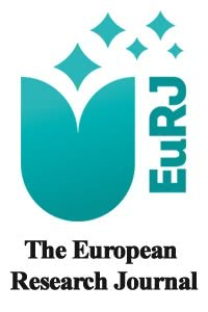Is semantic feature analysis effective when applied intensively? A randomized pilot study with non-fluent aphasic individuals
Is semantic feature analysis effective when applied intensively? A randomized pilot study with non-fluent aphasic individuals
Non-fluent aphasia, semantic feature analysis, intensive therapy, therapy effectiveness randomized controlled trial,
___
- 1. Basso A, Forbes M, Boller F. Rehabilitation of aphasia. Handbook of clinical neurology 2013;110:325-34.
- 2. Ayerbe L, Ayis S, Wolfe CD, Rudd AG. Natural history, predictors and outcomes of depression after stroke: systematic review and meta-analysis. Br J Psychiatr 2013;202:14-21.
- 3. Bergersen H, Frøslie KF, Sunnerhagen KS, Schanke, AK. Anxiety, depression, and psychological well-being 2 to 5 years poststroke. J Stroke Cerebrovasc Dis 2010;19:364-9.
- 4. Brady MC, Godwin J, Enderby P, Kelly H, Campbell P. Speech and language therapy for aphasia after stroke: an updated systematic review and meta-analyses. Stroke 2016;47:236-7.
- 5. Cherney LR. Aphasia treatment: intensity, dose parameters, and script training. Int J Speech Lang Pathol 2012;14:424-31.
- 6. Bhogal SK, Teasell R, Speechley M. Intensity of aphasia therapy, impact on recovery. Stroke 2003;34:987-93.
- 7. Boyle M, Coelho CA. Application of semantic feature analysis as a treatment for aphasic dysnomia. Am J Speech Lang Pathol 1995;4:94-8.
- 8. Boyle M. Semantic feature analysis treatment for anomia in two fluent aphasia syndromes. Am J Speech Lang Pathol 2004;13:236-49.
- 9. Coelho CA, McHugh RE, Boyle M. Semantic feature analysis as a treatment for aphasic dysnomia: a replication. Aphasiology 2000;14:133-42.
- 10. Conley A, Coelho C. Treatment of word retrieval impairment in chronic Broca’s aphasia. Aphasiology 2003;17:203-11.
- 11. Stahl B, Mohr B, Büscher V, Dreyer FR, Lucchese G, Pulvermüller F. Efficacy of intensive aphasia therapy in patients with chronic stroke: a randomised controlled trial. J Neurol Neurosurg Psychiatr 2018;89:586-92.
- 12. Harris PA, Taylor R, Thielke R, Payne J, Gonzalez N, Conde JG. Research electronic data capture (REDCap)—a metadata-driven methodology and workflow process for providing translational research informatics support. J Biomed Inform 2009;42:377-81.
- 13. Tunçer AM. Türkçe Konuşan Yetişkin popülasyonun Sözel Akıcılık Becerilerinin Yaş, Eğitim ve Cinsiyete Göre Incelenmesi ve sözcük Normlarının Oluşturulması. PhD Thesis, Anadolu University, Eskişehir, 2011. YÖKTEZ. Available online: https://tez.yok.gov.tr/UlusalTezMerkezi/TezGoster?key=1zw6GvYMe-q3Hf6HR-3US3_9_2-Unir63-vjn5IRCa9wGSTtEygZ_mNLonjSsYuQ (accessed on 01.06.2023).
- 14. Toğram B, Maviş İ. Validity, reliability and standardization study of the Language Assessment Test for Aphasia. Turkish Journal of Neurology 2012;18:93-103.
- 15. Toğram B. Sağlıklı ve inmeli bireylere uygulana afazide dil değerlendirme aracı’nın geçerlik, güvenirlik ve standardizasyon çalışması. PhD Thesis, Anadolu University, Eskişehir, 2008. YÖKTEZ. Available online: https://tez.yok.gov.tr/UlusalTezMerkezi/TezGoster?key=UPP_Zu9isEmWGFXFCBYasSww42qp-dcdG0lAd_n0udo9la0d2OnPwXgrdC0H6cw0 (accessed on 01.06.2023)
- 16. Kaplan E, Goodglass H, Weintraub S. The Boston Naming Test. Lea & Febige, 1983.
- 17. Yaşar E, Günhan Şenol NE, Ertürk Zararsız G, Birol NY. Adaptation of the Aphasia Impact Questionnaire-21 into Turkish: reliability and validity study. Neuropsychol Rehabil 2022;32:1550-75.
- 18. Allen L, Mehta S, Andrew McClure J, Teasell R. Therapeutic interventions for aphasia initiated more than six months post stroke: a review of the evidence. Topics Stroke Rehabil 2012;19:523-35.
- 19. Breitenstein C, Grewe T, Flöel A, Ziegler W, Springer L, Martus P, et al. Intensive speech and language therapy in patients with chronic aphasia after stroke: a randomised, open-label, blinded-endpoint, controlled trial in a health-care setting. Lancet 2017;389:1528-38.
- 20. Pulvermüller F, Neininger B, Elbert T, Mohr B, Rockstroh B. Koebbel P, et al. Constraint-induced therapy of chronic aphasia after stroke. Stroke 2001;32:1621-6.
- 21. Mohr B, Stahl B, Berthier ML. Intensive communicative therapy reduces symptoms of depression in chronic nonfluent aphasia. Neurorehabil Neural Repair 2017;31:1053-62.
- 22. Antonucci SM. Use of semantic feature analysis in group aphasia treatment. Aphasiology 2009;23:854-66.
- 23. Peach RK, Reuter KA. A discourse-based approach to semantic feature analysis for the treatment of aphasic word retrieval failures. Aphasiology 2010;24:971-90.
- 24. Boyle M. Semantic feature analysis treatment for aphasic word retrieval impairments: what's in a name? Topics Stroke Rehabil 2010;17:411-22.
- 25. Efstratiadou EA, Papathanasiou I, Holland R, Archonti A, Hilari K. A Systematic review of semantic feature analysis therapy studies for aphasia. J Speech Lang Hear Res 2018;61:1261-78.
- 26. Flowers HL, Skoretz, SA, Silver FL, Rochon E, Fang J, Flamand-Roze C, et al. Poststroke aphasia frequency, recovery, and outcomes: a systematic review and meta-analysis. Arch Phys Med Rehabil 2016;97:2188-201.
- 27. Meinzer M, Djundja D, Barthel G, Elbert T, Rockstroh B. Long-term stability of improved language functions in chronic aphasia after constraint-induced aphasia therapy. Stroke 2005;36:1462-6.
- ISSN: 2149-3189
- Yayın Aralığı: 6
- Başlangıç: 2015
- Yayıncı: Prusa Medikal Yayıncılık Limited Şirketi
Fatih KOCA, Fatih LEVENT, Ahmet Kağan AS, Fatih KÖKSAL, Ahmet Burak TATLI, Fahriye VATANSEVER, Mehmet DEMİR, Erhan TENEKECİOĞLU
Musculoskeletal pain and quality of life in patients undergoing hemodialysis: a single-center study
Ezgi ERSOY YEŞİL, Özlem PEHLİVAN, Zeki TOPRAK, Hasan KAYABAŞI, Dede ŞİT
The effect of adenoidectomy on pulmonary function in children: prospective controlled study
Ozlem YAGIZ AGAYAROV, Aynur ALİYEVA, Sayad KOCAHAN
Prognostic factors in atypical carcinoid tumors
Ahmet Bilgehan ŞAHİN, Erdem ÇUBUKÇU, Adem DELİGÖNÜL, Birol OCAK, Huseyin MELEK, Buket ERKAN OZMARASALİ, Burcu CANER, Ahmet BAYRAM, Elif Ülker AKYILDIZ, Türkkan EVRENSEL
Melin GECER, Nur BÜYÜKPINARBAŞILI, Seval TURNA, Mehmet BEŞİROĞLU, Zuhal GUCIN
Arzu OTO, Serbülent KILIÇ, Musa SAHIN
